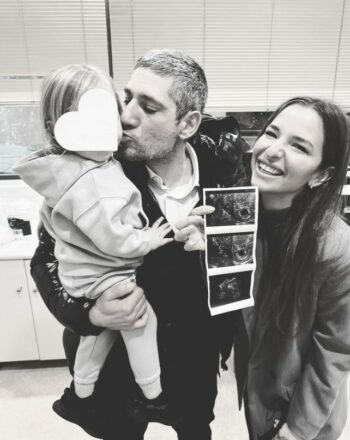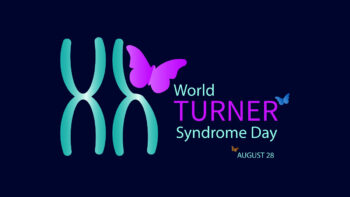With a profound confession in the “Kind Talks” podcast series and the “Almost Mama” episode, Irita Korkolo-Latsis spoke about the issue of Automatic eliminationan experience as painful as hers, as she shared in March With her post on Instagram She described in her program as a journey from guilt to relief, of “You killed my child” In the “A feeling of calm and gratitude came“, when she found out that she had given birth to the child she was carrying Turner syndrome, Sex-linked chromosomal abnormality in which all or part of the X chromosomes is missing (monosomy).

Photo: Erita Korkolos/Instagram
«I had gone on a long trip to America, pregnant, and when we came back for the ultrasound, we discovered that his heart had stopped when it was growing as it should.“, she says, recalling her transformation from The most relaxed person in the world During pregnancy -“I also travelled, played sports, and continued my life as usual, really just a time of joy and joy “Happiness” – for the man who wondered What did he really do wrong? -«Why did I go to America, and if I didn't go what would happen? I also developed salad poisoning. “I was thinking, even with the sip of wine I drank one night, that I had killed my child.”
Release from the pain of guilt came when the midwife informed her of it Turner syndrome –“Our child was a girl and this only happens to girls»–which brought cheerful And Great belief. «All that guilt I had committed was gone. A feeling of calm and gratitude came to me“He has been confessing”No matter what I did differently, that baby was gone. Could this pregnancy have progressed and I needed to make a decision in the fifth month that was much, much harder».
Related articles
Turner syndrome
Turner syndrome refers to… Exclusively female sexIt is estimated to occur in 1 in 2,000 to 2,500 births and will result in a 99% spontaneous miscarriage. Its appearance is not related to environmental factors and does not cause mental retardation.
According to the site Medscapeits clinical picture in Infants It includes swelling of the upper and lower extremities due to lymphedema and nail deformities – sausage-like fingers – while congenital hip dislocation is more common. according to childhood Short stature becomes apparent -On average 1.4 m-, With the transition to puberty accompanied by the absence of breast development, primary or secondary amenorrhea, due to ovarian failure, and infertility.
Other characteristics of the syndrome are a large number of moles, a wide neck with a cervical flap, and deformed wrists (Madelung's distortion), narrow and highly formed palate, deformities of the metatarsus and metatarsus, broad chest, eye problems (dropping eyelids, strabismus, strabismus, cataracts, red-green color blindness, etc.), hearing impairment, congenital malformations of the digestive system – The prevalence of Crohn's disease and ulcerative colitis is increased compared to the general population Cardiovascular system Kidneys, scoliosis, high blood pressure and hypothyroidism.
the He snorted Can be accomplished:
- Before birth, with fetal ultrasound that will show cystic fluid in the cervix, petal kidneys, cardiovascular anomalies or non-immune hydrops fetalis, with amniocentesis
- At birth, usually due to lymphedema in the neck,
- In childhood or adolescence, usually due to the absence of clinical characteristics at birth, in which case small stature, delayed onset of puberty or menopause will be alerted, with a specialized blood test, karyotype.
Regarding treatment, Treatment with Growth hormone (GH) or somatotropin During childhood it aims to prevent short stature, and estrogen replacement therapy – starting at the age of 11 years – to ensure and maintain healthy physical and sexual development, as well as reduce risks. Osteoporosis. 30-47% will be able to have a child with assisted reproduction and 2-3% naturally.
Endocrinologist, cardiologist, nephrologist or urologist, psychiatrist and geneticist are the specialties that will be required if a woman with Turner syndrome is consulted during her life, with attention paid to taking vitamin D and calcium to prevent osteoporosis, but also to maintain her health. Healthy body weight due to predisposition to Hypertension And Insulin resistance.
Research published in 2019 found lower life expectancy for women with the syndrome compared to the general population, and the leading cause of death was cardiovascular disease, followed by liver disease and cancer.
Butterfly girls

Image: Shutterstock
The syndrome is named after the American endocrinologist Henry Turner, who first described it in 1938. August 28, his birthday, has been designated as World Turner Syndrome Day and is celebrated mainly in the USA.
For the butterfly, it is a symbol of a chromosomal abnormality Turner Syndrome Association of America (TSSUS) states:
«Today, the butterfly is known around the world as a symbol of Turner syndrome. We even refer to ourselves as butterflies, sister butterflies, and golden butterflies. Many people wonder how this happened.
» In 2010, the Turner Syndrome Association of USA decided to update the organization's logo. The previous logo was thought to depict a dividing cell. One thing we've heard a lot from the community is that the logo looks like a butterfly.
» The four circles of the previous logo evolved into the distinctive butterfly wings of the world-famous TSSUS logo you see today. This development links our past to our present. The butterfly is feminine but also strong, like our limbs. Butterflies fly on their own, and that's what we hope everyone with Turner Syndrome will do with TSSUS always providing support».
Read also:
British research: One in 500 men has an extra chromosome – health risks
Congenital and hereditary diseases: What diseases will (not) be covered by the child’s insurance policy
Level B Ultrasound: Learn all about the most important pregnancy test





More Stories
Monica Bellucci and Tim Burton are more in love than ever at the Venice Film Festival – melting for each other
It hurt me as much as it hurt us all.
Marios Athanasiou Shocked: ‘Tighter Penalties for Rape and…’ | Celebrity News